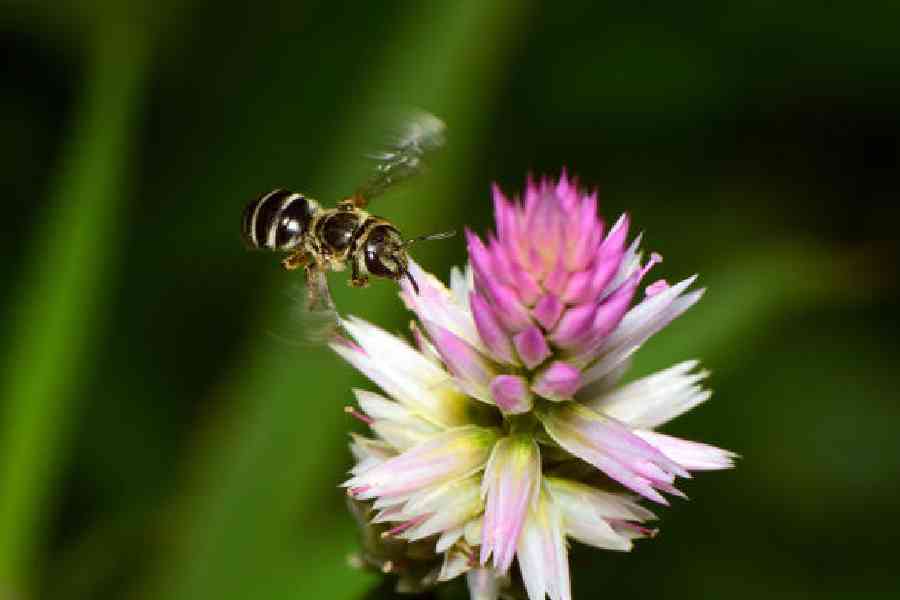Asian honeybees have an impressive playbook of tactics to defend their hives: hypnotic shimmering waves to warn off predatory hornets, defensive balls to roast intruders alive with their body heat, and, of course, their once-in-a-lifetime use of a stinger.
Add another weapon to the honeybee arsenal: wings. Scientists in Japan have learned that Asian honeybee guards use their wings to slap pesky ants into next week. Slow-motion video published with a study in the journal Ecology shows what happens when ants try to sneak into the hive’s entrance: the guard bee angles up to the ant like a tennis player setting up a mean backhand, then wing-smacks the ant so hard it tumbles end-over-end through the air as it plummets to the ground.
Researchers say wing-slapping seems to be a low-energy way for Asian honeybees to send petty thieves packing — while Japanese ants don’t often kill honeybees, they can drain the nest’s food reserves and gobble up the bees’ protein-rich eggs.
To see how the strategy works, a team of researchers at Japan’s National Institute for Environmental Studies trained slow-motion cameras on guard bees as they were confronted with various ant species invading their hive.
The replays revealed the bees’ wing-slaps sent smaller ant species sailing about half the time. When a wing slap doesn’t connect, the ants will occasionally try to bite the guard bee but generally “just freeze”, said Kiyohito Morii, an author of the study and a behavioural ecologist at the Japanese institute. The wing-slap may be too fast for the ant to even perceive it, added Yoshiko Sakamoto, another study author and a senior researcher at the same institution.
Bigger ants posed more of a challenge — but the honeybee guards occasionally got their licks in. About one out of 10 wing-slaps successfully dislodged Japanese wood ants, which are almost the same size as the bees and are significantly more agile than the smaller ants.
The researchers say wing-slapping seems to require less effort than other, more energy-intensive bee-jitsu moves such as wing-fanning, in which the bee flutters its wings to blow the ant away without touching it. That makes a difference because fending off a stream of ant invaders can become an exhausting game of Whac-a-Mole as ants wear down the bees’ defences with sheer numbers.
Wing-slapping is only an option, researchers add, because ants in Japan aren’t much for mandible-to-mandible combat — direct contact with the ants isn’t dangerous for the bees. But it’s likely to be less successful against more aggressive invasive species like the bigheaded ant, which is known to kill and devour healthy worker bees.
Asian honeybees, a species distinct from those found in Europe and North America, are important crop pollinators. One benefit of the research is that studying their defensive techniques may help scientists understand how they will stand up to invasive species and other emerging threats.
“Humans are always paying attention to how bees survive and thrive,” says Heather Mattila, a professor at Wellesley College in the US, who researches the behaviour of Asian bees and wasn’t involved in the study. “We need to understand how we can help them because they do so much for us.”
But why don’t European bees seem to know how to wing-slap? “The Asian bees have evolved in an area of the world where they’re under some of the worst insect predatory pressure on the planet,” Mattila says.
That means they’ve had to get creative.
In 2020, Mattila and her team discovered that Asian honeybee hives sometimes build a fence of filth around the entrance to their nests with animal faeces. Researchers believe the scent of this poop perimeter could ward off attacks on their nests from predatory insects, for example, from so-called murder hornets.
Morii says they saw the Asian honeybees in their study using a variation of that defensive tactic — but this time, instead of animal faeces, they used the body parts of other, as-yet-unidentified insects as a grisly unwelcome mat.
“Asian honeybees are extremely inventive, and after hundreds of years, we’re still finding out new ways they defend themselves,” Mattila said. “You just can’t count them out.”
NYTNS











